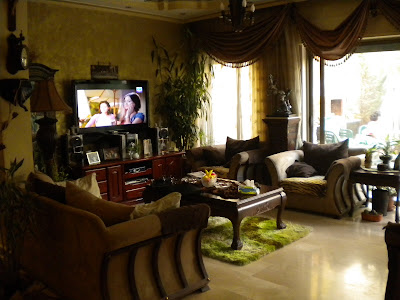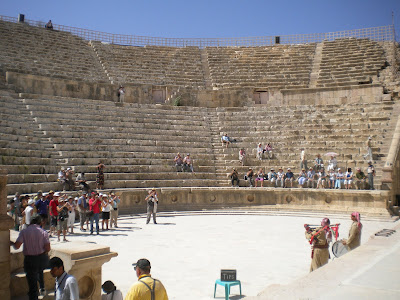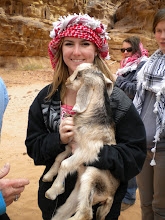From there we continued to the border, where they stamped our passports with border control stuff and we sent Jiries’ suitcase and my backpack through multiple x-ray machines. Then we waited almost an hour for a bus, and then the bus took us about 10 minutes across the Jordan River, where we caught a taxi to Amman. We arrived at Rona’s house in time for lunch, which was delicious. Rana and her husband Hanna have 3 daughters and one son, and their cousin from Beit Sahour is staying with them until he leaves for university soon. We spent the afternoon hanging out until Hanna got home, then Jiries, Rona, Hanna and I went out to pick up their youngest daughter and see some sights around Amman.
Border station:



The Jordan River:


Rona's house:


Amman is surrounded by 7 massive mountains: Jebel (which means mountain) El Hussein, Jebel El Taj, Jebel El Joofa, Jebel El Mareej, Jebel Asharafia, Jebel El Ahkhader, and Jebel Amman. There are around 2 million people living in Amman, comprising about 1/3 of the entire population of Jordan. Needless to say, it is extremely crowded. Back in the day the city was a Roman stronghold- they called it “Philadelphia”. We drove on a few of the mountains, and stopped for a few minutes on a hill in the middle of the city to admire the 360 view of lights. The mountain sides are super overpopulated; it looks like there isn’t even a square inch of open space. There are also tons of ruins from ancient Philadelphia, many that are still being excavated. We walked around the ruins- they looked awesome lit up at night, and there is an absolutely enormous amphitheater in perfect condition.









When we got home I stayed up (way too late) with the kids playing card games and watching Arabic soap operas. This morning Jiries and I were up and out of the house by 9 on our way to the town of Jarash. There we visited one of the largest and most well preserved sites of Roman architecture in the world (outside of Italy). According to the brochure, archeologists have found ruins of settlements dating back to the Neolithic Age, indicating human occupation of the location for more than 6,500 years. The pamphlet also describes the ancient city as “a blend of the Greco-Roman world of the Mediterranean basin and the ancient traditions of the Arab Orient.” We walked through the ruins for over 2 hours in the sweltering heat, the ruins were really amazing.
The entrance:













After Jerash we took the scenic route to Madaba, a small town famous for its mosaics and handicrafts. It is the home of the Greek Orthodox Church of St. George, built in 1884 over the remains of a Byzantine church. It took us forever to find the church, and I pretty much have the whole town memorized now, but it was totally worth finding it once we saw the famous mosaic map on the floor of the church. The map, which dates to around 580 AD, was made to cover the front section of the floor in the Byzantine church, but only part of the map has been preserved. As you can see in pictures below, the mosaic map is really incredible, and so are all of the ones on display in the church. The main focal point of the map is the walled city of Jerusalem- which you can kind of see in the picture. After visiting the church we walked around the town for a while and went into lots of the mosaic shops. There is a considerable Christian population in the town (hence the church) so it wasn’t hard for us to find an open restaurant to grab a few sandwiches (all the stores owned by Muslims are closed for Ramadan fasting).


A map of the map:



The towns were really interesting to drive through; the people dress in the most extreme varieties of clothing, including some traditional Arab and/or Islamic clothing that sort of made me feel like we had gone back in time.






Stuck in traffic:








After Madaba we drove to Mount Nebo, which is where the Bible says that Moses stood on the mountain top and God showed him Jerusalem, then told him he would never make it there. The site is now home to a famous tourist attraction run by the Franciscan church. The view from the top of the mountain is beautiful; it overlooks the Jordan Valley, the Dead Sea, Israel, and Palestine. It was breezy and pleasant, a nice change from the blazing sun all day.




Two thumbs up for the Franciscan church:

Picture from the museum on the mountaintop:

We drove down Mount Nebo to Ein Mosa, which means the spring of Moses, where Moses stopped to pray after his conversation with God on the mountain. There he whacked a rock with his cane and from that moment water began gushing out; thus, in the valley of the mountain there is a beautiful oasis, even though the spring is more like a small trickle that you can't even see in the pictures. Even though it is small, it is more water than in most places, and today it is used for agricultural purposes and lots of Bedouins hang out there.



After that we drove home and got horribly lost, but after asking about 2 dozen people for directions we finally found our way. The people here are extremely friendly; several of them changed the direction they were going in so we could follow them and find our way. Jiries’ niece’s family is also really nice and incredibly hospitable. They make fun of me and say I act like I am a Sahouri (from Beit Sahour) and definitely not from Jordan, because my Arabic has the West Bank accent (they pronounce the k’s as g). We ate dinner, and since then I’ve been writing this. Tomorrow we are going to Aqaba with Jiries' niece Jane and Rana's daughter Haneen. Jiries is going to show off his snorkel skills for me!! (Little known fact: Jiries used to own a snorkel shop in Colorado, believe it or not!). More to come!


No comments:
Post a Comment